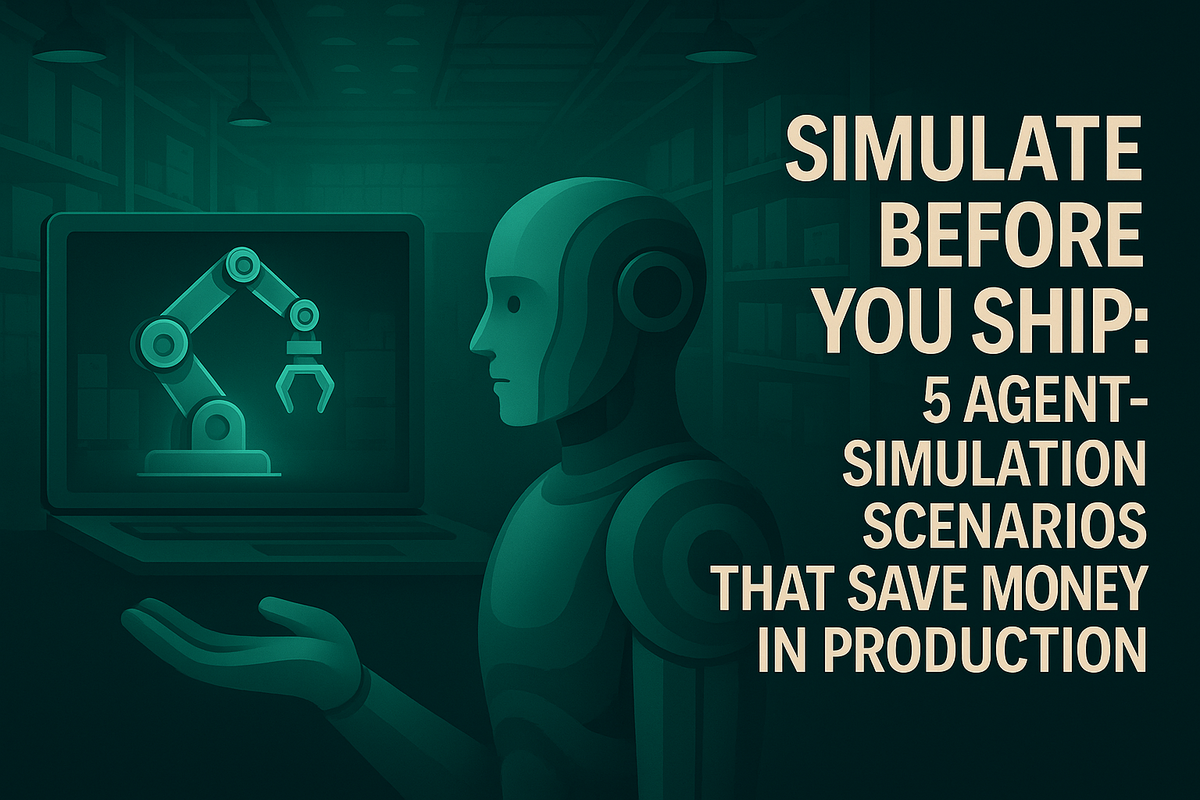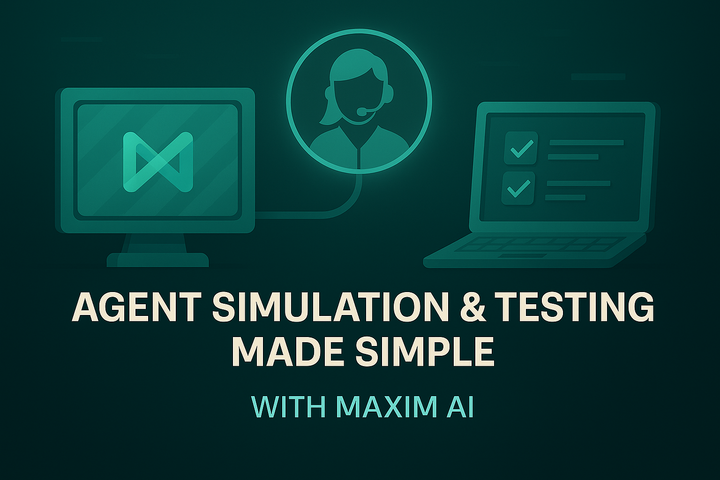Simulate Before You Ship: 5 Agent-Simulation Scenarios That Save Money in Production

In the rapidly evolving world of AI-powered applications, agent-based systems are transforming how enterprises automate workflows, deliver customer experiences, and optimize operations. However, deploying AI agents directly into production environments without thorough testing can lead to costly failures, unexpected downtime, and diminished user trust. Simulation-driven development offers a solution: by rigorously testing agents in virtual environments that mirror real-world conditions, organizations can anticipate risks, refine agent behavior, and ensure reliable performance before launch.
This article explores five practical agent-simulation scenarios that help enterprises save money, reduce risk, and accelerate time-to-value. We’ll also showcase how Maxim AI’s robust simulation and evaluation tools empower teams to build, test, and deploy production-ready agents with confidence. For a deeper dive into agent evaluation, see AI Agent Quality Evaluation and Evaluation Workflows for AI Agents.
Why Simulate Before You Ship?
Simulation is a cornerstone of modern engineering and scientific research. In AI development, simulation allows teams to:
- Test agent behavior across diverse scenarios
- Identify failure modes before deployment
- Optimize resource allocation and system design
- Mitigate risks associated with unpredictable user interactions
- Ensure compliance with regulatory and safety requirements
Simulation-driven approaches are widely adopted in industries such as supply chain logistics, manufacturing, and enterprise software, where agent-based models are used to forecast outcomes, optimize workflows, and validate system reliability (ScienceDirect, AnyLogic). For AI agents, simulation helps bridge the gap between controlled development environments and messy, unpredictable real-world operations (Salesforce).
Scenario 1: Customer Support Edge Case Simulation
Problem
Customer support agents face a wide range of queries, from routine requests to complex problem-solving. Unanticipated edge cases (such as ambiguous questions, adversarial users, or incomplete information) can expose weaknesses in agent logic and lead to poor customer experiences.
Simulation Approach
By simulating thousands of support interactions, including rare and challenging scenarios, teams can systematically evaluate agent robustness. Maxim AI’s agent simulation workflows allow you to generate synthetic conversations that mimic real customer behavior, including multi-turn dialogues and adversarial exchanges. This enables comprehensive testing of escalation protocols, fallback strategies, and language understanding.
Value
- Reduced downtime from unexpected issues
- Improved customer satisfaction
- Lower support costs through automated triage
For details on agent evaluation metrics, refer to AI Agent Evaluation Metrics.
Scenario 2: Workflow Automation Stress Testing
Problem
AI agents that automate business workflows (such as order processing, lead qualification, or document approval) must handle high transaction volumes and complex dependencies. Bottlenecks and resource contention can degrade system performance and increase operational costs.
Simulation Approach
Workflow automation simulation involves modeling agent interactions with backend systems, APIs, and databases under varying loads. By stress-testing agents in virtual environments, teams can identify scalability limits, optimize queue management, and validate error-handling routines. Maxim AI’s simulation platform supports integration with enterprise data sources and synthetic load generation, enabling end-to-end workflow validation.
Value
- Prevents costly production outages
- Optimizes infrastructure sizing
- Accelerates incident response
Explore Maxim’s approach to workflow evaluation at Evaluation Workflows for AI Agents.
Scenario 3: Multi-Agent Collaboration and Coordination
Problem
Complex business processes often require multiple AI agents to collaborate such as in supply chain management, project coordination, or multi-departmental support. Coordination failures, race conditions, or communication breakdowns can lead to inefficiency and lost revenue.
Simulation Approach
Multi-agent simulation models the interactions, negotiation, and decision-making among autonomous agents. Using Maxim AI, teams can design scenarios where agents must share information, resolve conflicts, and coordinate actions across organizational boundaries. Simulation tools such as AnyLogic and Maxim’s agent tracing capabilities enable visualization and analysis of agent workflows, communication patterns, and system bottlenecks.
Value
- Reduces risk of coordination failures
- Improves throughput and process reliability
- Enables proactive resolution of inter-agent dependencies
For advanced tracing and debugging tools, see Agent Tracing for Debugging Multi-Agent AI Systems.
Scenario 4: Compliance and Safety Scenario Simulation
Problem
Regulated industries (such as finance, healthcare, and insurance) require AI agents to comply with strict policies and safety protocols. Non-compliance can result in legal penalties, reputational damage, and financial loss.
Simulation Approach
Compliance simulation involves creating scenarios that test agent adherence to business rules, privacy regulations, and ethical guidelines. Maxim AI’s evaluation platform allows teams to inject synthetic compliance scenarios, audit agent decision-making, and monitor for policy violations. Integration with Maxim’s observability tools ensures ongoing compliance monitoring in production.
Value
- Mitigates regulatory risk
- Ensures safe and ethical agent behavior
- Reduces cost of compliance audits
Learn more about AI reliability and compliance at AI Reliability: How to Build Trustworthy AI Systems.
Scenario 5: Real-World Noise and Adversarial Testing
Problem
Real-world environments are unpredictable. Agents may encounter noisy data, conflicting information, or adversarial inputs that can compromise performance.
Simulation Approach
Noise and adversarial scenario simulation introduces variability into agent inputs such as slang, typos, regional dialects, or intentionally misleading queries. Maxim AI’s simulation framework supports the generation of “messy” test data, enabling teams to assess agent resilience and adaptability. By simulating adversarial conditions, organizations can proactively strengthen agent defenses against manipulation and error.
Value
- Enhances agent robustness
- Protects against security vulnerabilities
- Improves reliability in production
For strategies on building resilient agents, refer to How to Ensure Reliability of AI Applications: Strategies, Metrics, and the Maxim Advantage.
How Maxim AI Accelerates Simulation-Driven Development
Maxim AI provides a comprehensive suite of tools for agent simulation, evaluation, and monitoring. Key features include:
- Agent Simulation Workflows: Build and execute scenario-based simulations that mirror real-world agent interactions.
- Quality Evaluation Metrics: Measure agent performance across accuracy, reliability, compliance, and user satisfaction.
- Observability and Tracing: Visualize agent decision paths, debug multi-agent systems, and monitor production behavior.
- Integration with Enterprise Data: Connect simulations to real or synthetic enterprise datasets for realistic testing.
- Scalable Cloud Infrastructure: Accelerate large-scale simulation experiments and manage model versions efficiently.
To see Maxim AI in action, book a live demo at Maxim Demo.
Case Study Highlights
Organizations across industries have leveraged Maxim AI’s simulation capabilities to deliver production-ready agents:
- Clinc: Elevated conversational banking with robust simulation and quality evaluation (Read more).
- Thoughtful: Built smarter AI workflows through scenario-driven testing (Read more).
- Comm100: Delivered exceptional support with agent simulation and workflow optimization (Read more).
- Mindtickle: Improved AI quality evaluation using Maxim’s simulation tools (Read more).
- Atomicwork: Scaled enterprise support with seamless simulation-driven quality management (Read more).
Best Practices for Agent Simulation
- Define clear objectives: Identify key scenarios and metrics aligned with business goals.
- Leverage synthetic and real data: Mix synthetic scenarios with real-world datasets for comprehensive coverage.
- Iterate and refine: Continuously improve agent logic based on simulation outcomes.
- Integrate observability: Monitor agent decisions and system health throughout the simulation lifecycle.
- Collaborate across teams: Involve stakeholders from engineering, compliance, and business functions for holistic validation.
For more on prompt management and optimization, see Prompt Management in 2025: How to Organize, Test, and Optimize Your AI Prompts.
Conclusion
Simulating agent behavior before production deployment is essential for building reliable, cost-effective, and scalable AI systems. By testing agents across diverse scenarios (from customer support edge cases to compliance audits and adversarial challenges) organizations can anticipate risks, optimize performance, and deliver exceptional user experiences.
Maxim AI stands at the forefront of simulation-driven agent development, offering the tools, workflows, and expertise needed to ship production-ready agents with confidence. To learn more, explore Maxim’s blog, articles, and case studies, or schedule a personalized demo at getmaxim.ai/schedule.
Further Reading and Resources
- AI Agent Quality Evaluation
- Evaluation Workflows for AI Agents
- Agent Evaluation vs Model Evaluation: What’s the Difference and Why It Matters
- AI Reliability: How to Build Trustworthy AI Systems
- LLM Observability: How to Monitor Large Language Models in Production
- Agent Tracing for Debugging Multi-Agent AI Systems
- How to Ensure Reliability of AI Applications: Strategies, Metrics, and the Maxim Advantage
- What Are AI Evals?
For authoritative resources on simulation modeling and agent-based systems, visit ScienceDirect, AnyLogic, and Salesforce AI Research.
